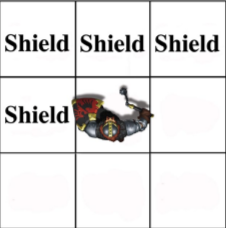Attacking, Defending, and Special Effects
Attacks and Parries
Combat is performed in the following fashion:
- On their turn the attacker spends an Action Point, rolls against their Combat Style, and notes the result.
- If desired, the defender spends an Action Point to Parry, rolling against their Combat Style, and notes the result.
- The success levels of the results are compared as per a normal Differential Roll
- The character with the higher level of success gains a number of Special Effects equal to the level of success won (see the table below). No special effects are granted to either character if both players fail or fumble.
- If the attacker achieved a success or critical, they may roll weapon damage and add their Damage Modifier (if any). Roll to see which hit location will be hit.
- If the defender achieved a success or critical, reduce any damage inflicted according to the comparative sizes of the weapons involved (see the table below).
If a character cannot defend themselves, or chooses not to, treat it as if they failed their roll to parry for determining if Special Effects are gained. No damage need be done as an attacker to gain special effects, and it is possible to gain a special effect while receiving damage as a defender. Ranged attacks cannot be parried normally, though Shields do have a trait allowing them to parry normal ranged attacks. Firearms, unlike other ranged attacks, cannot be parried by shields.
For more information about applying damage and wounds, see here.
Determining Levels of Success for Differential Rolls
Parrying Damage Reduction
| Attacking Weapon | ||||||
|---|---|---|---|---|---|---|
| Small | Medium | Large | Huge | Enormous | ||
| Small | All | Half | None | None | None | |
| Medium | All | All | Half | None | None | |
| Large | All | All | All | Half | None | |
| Defending Weapon | Huge | All | All | All | All | Half |
| Enormous | All | All | All | All | All |
Evading an Attack
A defender may also choose to evade instead of parrying, rolling Evade instead of combat style and using the same rules for Different Rolls to determine the amount of Special Effects. After the attack is completed, the defender is left prone nearby.
Passive Blocking
If a character is struck in a hit location passively blocked by a shield or other weapon, reduce the incoming damage of the attack as if the equipement passively blocking the attack had succeeded on a parry. This does not count as a success for the purposes of gaining Special Effects. If a firearm hits a location being passively blocked, reduce the incoming damage by the Armor Points of the weapon or shield rather than using the parry damage reduction rules.
Cover
Characters can hide behind things to obscure or protect themselves. When an attack would land on a body location covered by an obstacle it strikes that obstacle first, potentially completely blocking the blow. If the target is completely covered, the attacker can still try to blindly attack the cover if they can penetrate it, but the attack is one grade more difficult as they can not see the exact locations to attack. This is particularly important for the sake of concealment in cover that will not provide substantial protection, such as hiding in bushes or behind paper walls.
Knockback
Any attack that imparts more damage than the SIZ of the victim (before any reductions), results in the victim being knocked back. The victim must pas an easy Acrobatics or standard Athletics roll to avoid falling prone. They are also thrust backwards one meter per each five points of damage in excess of their SIZ. Proactively using the Brace combat action can reduce or even negate the effects of knockback.
Pulled Blows
Occasionally a character may wish to avoid maiming or killing an opponent. This is achieved by 'pulling' a blow, limiting the force placed behind it or striking with a less lethal part of the weapon. A pulled blow halves the damage inflicted on a successful hit. The intent to pull a blow must be announced before the attack is made, since it is near impossible to withold a fully commited strike.
Facing and Melee Combat
One handed weapons can attack and parry targets within the front squares or the square on the side wielding the weapon (see the above image as an example for a shield wielded in the left hand) without receiving a penalty. Shields can only attack and parry in those squares due to their ungainly nature. Other one handed wepaons can attack and parry the side square opposite the weapon hand, but have a one grade difficulty penalty applied.
One handed weapons trying to attack a target in their back squares receive a Herculean difficulty grade penalty, but parrying an attack coming from their back squares with a one handed weapon is only a Formidable difficulty grade penalty. To attack or parry back squares, a Perception roll is required. Shields cannot attack or parry from their back squares.
Two handed weapons can attack and parry without penalty only in the front squares. Attacking and parrying the side squares imparts a one difficulty grade penalty. Two handed weapons follow the same penalties as one handed weapons for attacking and parrying back squares.
Evading can be done without a difficulty grade penalty from attacks from all squares other than the back squares. Evading an attack from a back square requires a successful Perception roll, and even then the evade check has a Formidable grade penalty.




Comments